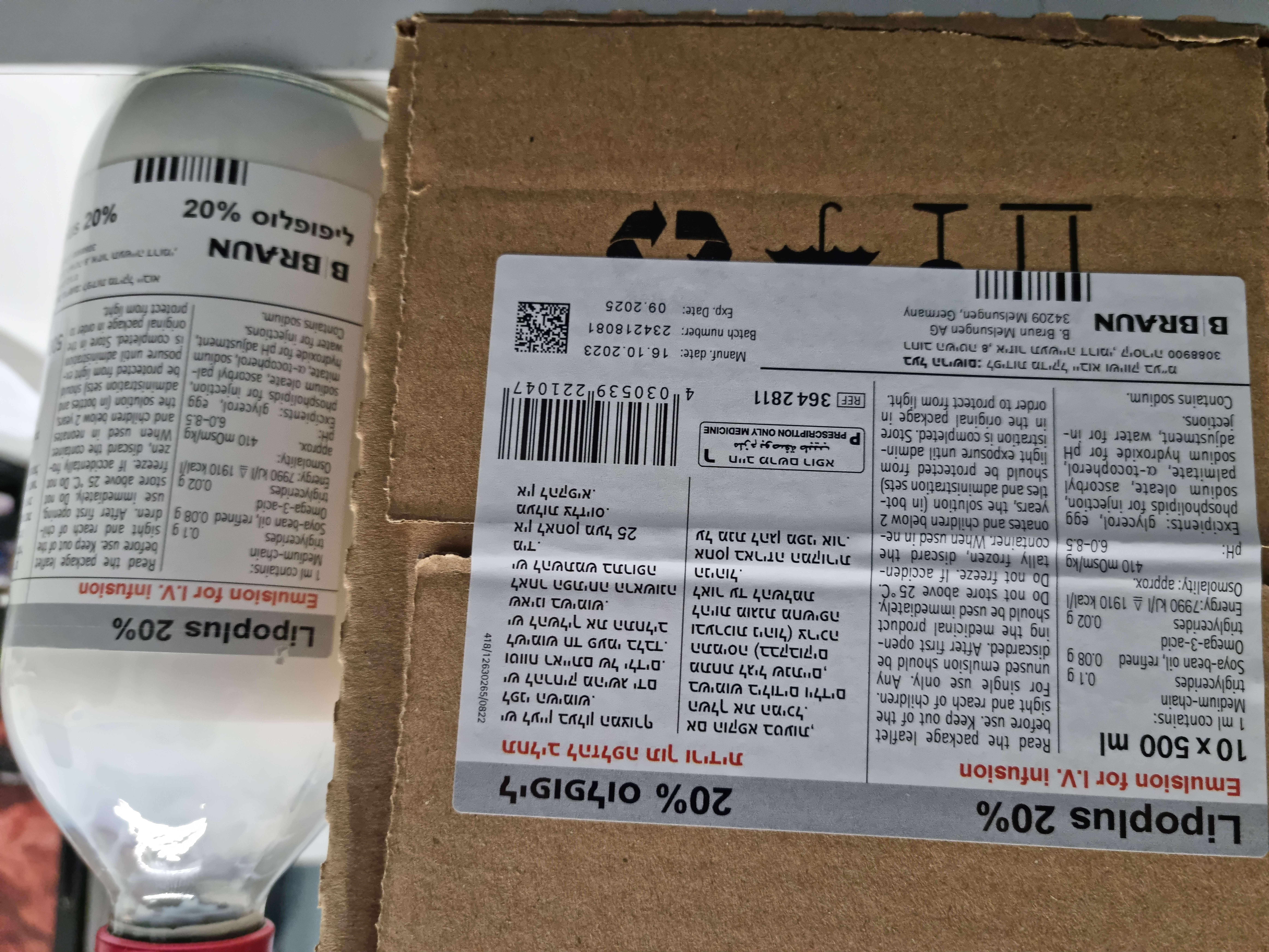Quest for the right Drug

ליפופלוס 20% LIPOPLUS 20 % (OMEGA-3, SOYA BEAN OIL, REFINED, TRIGLYCERIDES, MEDIUM-CHAIN)
תרופה במרשם
תרופה בסל
נרקוטיקה
ציטוטוקסיקה
צורת מתן:
תוך-ורידי : I.V
צורת מינון:
תחליב לאינפוזיה : EMULSION FOR INFUSION
עלון לרופא
מינוניםPosology התוויות
Indications תופעות לוואי
Adverse reactions התוויות נגד
Contraindications אינטראקציות
Interactions מינון יתר
Overdose הריון/הנקה
Pregnancy & Lactation אוכלוסיות מיוחדות
Special populations תכונות פרמקולוגיות
Pharmacological properties מידע רוקחי
Pharmaceutical particulars אזהרת שימוש
Special Warning עלון לרופא
Physicians Leaflet
Special Warning : אזהרת שימוש
4.4 Special warnings and precautions for use The serum triglyceride concentration should be monitored when infusing Lipidem 200mg/ml. In patients with suspected disorders of lipid metabolism, fasting hyperlipidaemia should be ruled out before the start of the infusion. Depending on the patient’s metabolic condition, occasional hypertriglyceridaemia may occur. If the plasma triglyceride concentration exceeds 4.6 mmol/l (400 mg/dl) in adults during administration of lipids it is recommended to reduce the infusion rate. The infusion must be interrupted if the plasma triglyceride concentration exceeds 11.4 mmol/l (1000 mg/dl), as these levels have been associated with an increased risk for acute pancreatitis. Disturbances of the fluid, electrolyte or acid-base balance must be corrected before the start of infusion. Refeeding or repletion of malnourished or depleted patients may cause hypokalaemia, hypophosphataemia and hypomagnesaemia. Adequate supplementation of electrolytes according to deviations from normal values is necessary. Controls of the serum electrolytes, the water balance, the acid-base balance, and of blood cell counts, coagulation status, hepatic and renal function are necessary. Any sign or symptom of anaphylactic reaction (such as fever, shivering, rash or dyspnoea) should lead to immediate interruption of the infusion. Energy supply with lipid emulsions only could cause metabolic acidosis. It is therefore recommended to infuse an adequate quantity of intravenous carbohydrates or carbohydrate- containing amino acid solutions along with the fat emulsion. For patients requiring complete parenteral nutrition, complementary carbohydrate, amino acid, electrolyte, vitamin, and trace element supplements are required. Also, an adequate total fluid intake has to be ensured. Impaired capacity to eliminate triglycerides can lead to “fat overload syndrome” which may be caused by overdose (see section 4.8 and 4.9.). Mixing with incompatible substances might lead to breaking of the emulsion or to precipitation of particles (see sections 6.2 and 6.6), both resulting in a high risk of embolism. There is as yet only limited experience of the use of Lipidem 200mg/ml for periods longer than seven days. As with all intravenous solutions, especially for parenteral nutrition, strict aseptic precautions are necessary for the infusion of Lipidem 200mg/ml. Patients with diabetes mellitus, impaired cardiac or renal function Like all large-volume infusion solutions, Lipidem 200mg/ml should be administered with caution to patients with impaired cardiac or renal function. There is only limited experience of its use in patients with diabetes mellitus or renal failure. Patients with impaired lipid metabolism Lipidem 200mg/ml should be administered cautiously to patients with disturbances of lipid metabolism with increased serum triglycerides, e.g. renal insufficiency, diabetes mellitus, pancreatitis, impaired hepatic function, hypothyroidism (with hypertriglyceridaemia), sepsis, and metabolic syndrome. If Lipidem 200mg/ml is given to patients with these conditions, more frequent monitoring of serum triglycerides is necessary to assure triglyceride elimination and stable triglyceride levels below 11.4 mmol/l (1000 mg/dl). In combined hyperlipidaemias and in metabolic syndrome, triglyceride levels react to glucose, lipids and overnutrition. Adjust dose accordingly. Assess and monitor other lipid and glucose sources, and drugs interfering with their metabolism. The presence of hypertriglyceridaemia 12 hours after the administration of lipids also indicates disturbance of lipid metabolism. Paediatric population Free fatty acids (FFA) compete with bilirubin for albumin binding sites. Especially very premature infants may be at increased risk of hyperbilirubinaemia due to high levels of FFA released from triglycerides resulting in a high FFA/albumin ratio. In parenterally fed infants at risk of hyperbilirubinaemia, serum triglyceride and bilirubin levels should be monitored and lipid infusion rate be adjusted if deemed necessary. During infusion Lipidem 200mg/ml should be protected from phototherapy light to decrease the formation of potentially harmful triglyceride hydroperoxides. The serum triglyceride concentration should be regularly monitored during the infusion of Lipidem 200mg/ml, (especially in very small preterm infants), especially if there is an increased risk of hyperlipidaemia (e.g. in situations of stress or infection). A stepwise increase of the daily dose may be advisable. Depending on the patient’s metabolic condition, occasional hypertriglyceridaemia may occur. In infants dose reduction should be considered if the plasma triglyceride concentration during infusion exceeds 2.8 mmol/l (250 mg/dl). In older children and adolescents dose reduction should be considered if the plasma triglyceride concentration during infusion exceeds 4.6 mmol/l (400 mg/dl). Light exposure of solutions for intravenous parenteral nutrition, especially after admixture with trace elements and/or vitamins, may have adverse effects on clinical outcome in neonates, due to generation of peroxides and other degradation products. When used in neonates and children below 2 years, Lipidem 200mg/ml should be protected from ambient light until administration is completed (see sections 4.2, 6.3 and 6.6). Special warnings/precautions regarding excipients This medicinal product contains 59.8 mg sodium per 1000 ml, equivalent to 3 % of the WHO recommended maximum daily intake of 2 g sodium for an adult. Interference with laboratory tests Lipids may interfere with certain laboratory tests (such as bilirubin, lactate dehydrogenase, oxygen saturation) when the blood sample is taken before the lipids have been eliminated from the bloodstream, this may take 4 to 6 hours.
Effects on Driving
4.7 Effects on ability to drive and use machines Not relevant.

שימוש לפי פנקס קופ''ח כללית 1994
לא צוין
תאריך הכללה מקורי בסל
לא צוין
הגבלות
לא צוין
מידע נוסף
